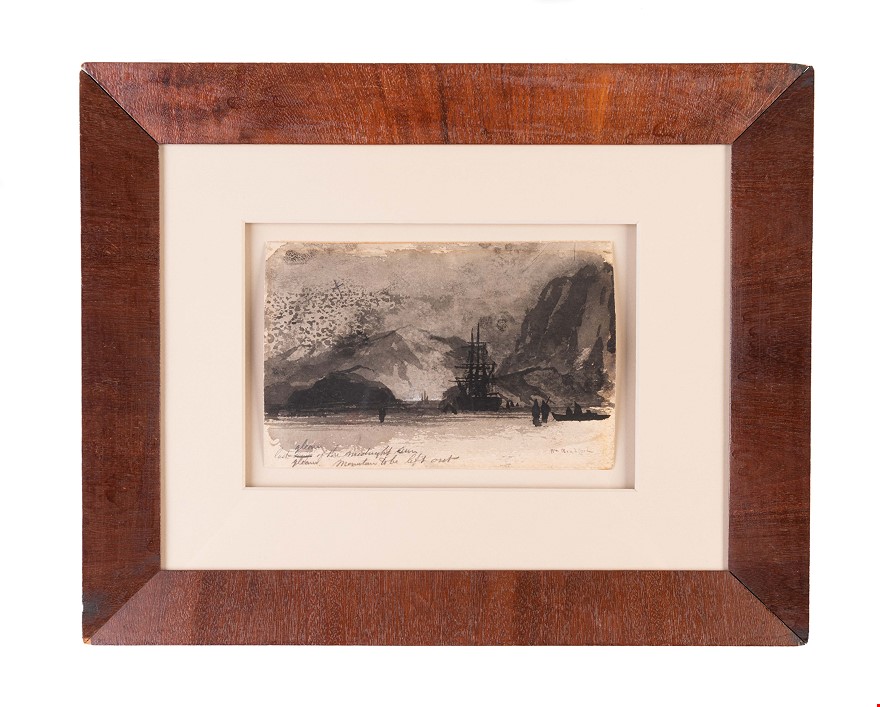Last Gleam of the Midnight Sun.
BRADFORD William (1878.)
£12500.00
Please contact us in advance if you would like to view this book at our Curzon Street shop.
A PREPARATORY STUDY FOR "MIDNIGHT SUN, THE ARCTIC."
Watercolour on card measuring 182 by 120mm. Signed and captioned by the artist. Framed and glazed. Np, nd, c.1869 -
A wonderful survival with excellent provenance. This watercolour is a preparatory study for Bradford's famous oil painting, "Midnight Sun, The Arctic."
Born in Fairhaven, Mass., at the peak of the American whaling industry, William Bradford (1823-1892) began, and enjoyed considerable success, as a maritime painter. In 1861, "inspired by the exploits of Arctic explorers such as Sir John Franklin and Elisha Kent Kane and, most likely, by the phenomenal success of Frederic Church's painting The Icebergs (1861), which had been unveiled to the New York public that spring, Bradford charted a ship to chase icebergs off the coast of Labrador. This was the first of the artist’s six or seven arctic voyages, and from that time on he made arctic scenes his specialty. He painted silver icebergs riding on glassy water, ice flows lit by lurid sunset skies, and sailing ships breaking their way through frozen seas under the eyes of inquisitive polar bears. His Arctic is a stunningly beautiful yet treacherous place, where the human presence is always marginal and often threatened. Bradford’s arctic paintings include Ice Dwellers Watching the Invaders (c. 1870; New Bedford Whaling Museum, New Bedford, Mass.), Arctic Scene (1870; Indiana University Art Museum, Bloomington), Arctic Scene (1876; University of La Verne, La Verne, Calif.), and Caught in the Ice Flows (Addison Gallery of American Art, Andover, Mass.)" (ANB).
In 1869, he made his final voyage to the arctic in the company of Isaac Hayes and the Boston-based photographers, John Dunmore and George Critcherson. They sailed to Baffin Bay, lived with the Inuit, and explored the geography of northern Greenland. The result was the landmark work, The Arctic Regions (London, 1873). "The photographs, sketches, and memories from this and the earlier polar expeditions became the bases of Bradford’s work for the rest of his career. He also drew on these sources for his many illustrated lectures on the Arctic, which he delivered to appreciative audiences in both the United States and England" (ibid). Bradford exhibited frequently at the National Academy of Design in New York, the Boston Athenaeum, and in 1875 the Royal Academy of Arts in London.
Isaac Israel Hayes, who accompanied Bradford on his final voyage and published an account, described them seeing the midnight sun: "We might have been in a state of constant terror had we not been in a state of constant admiration ... The hour was approaching midnight, and the sun, nearing the north, gradually dipped until it had touched and finally passed close to the horizon, with its upper limb just about the line of waters. For some time previous the sky had been particularly brilliant; but when the sun went fairly down, the little clouds, which had before been tipped with crimson, melted away, and the whole sky became uniformly golden; while the sea, quite motionless, unruffled by even the slightest breath of air, reflected the gorgeous color like a mirror."
The bones of the finished image, "Midnight Sun, The Arctic", are clearly evident in this study. The major difference between the two is the mountain in the centre background. However, Bradford has added a note beside the title, stating "Mountain to be left out" and thus we see the artist at work, and his method of composition. The midnight sun in the arctic was a recurring image in his polar works, for example, "Summer in the Land of the Midnight Sun" (nd); "The Panther off the coast of Greenland under the Midnight Sun" (1873); and the untitled "Arctic Scene" held at Laverne University all feature it.
In 1879, Bradford was living in San Francisco, where he met George Washington De Long and his wife, Emma. Bradford introduced De Long to local whaling captains and he drew on their experiences in the planning of his own voyage. Emma De Long remained in close touch with the Bradfords after her husband set sail, and for the rest of her life. This study might have been given to them, or her, at any time.
George De Long (1844-81) graduated from the US Navy Naval Academy in 1865. His first voyage to the arctic was on Capt. D.L. Braine's relief ship, Juniata, to rescue survivors on Charles F. Hall's Polaris expedition in 1873. Having developed a taste for arctic waters, by 1877 he had successfully lobbied the newspaper proprietor James Gordon Bennett (of Henry Stanley fame) to sponsor an expedition to the North Pole. Bennett purchased the Pandora from Allen Young, which they rechristened Jeannette. The expedition departed San Francisco on 8 July 1879 and sailed north into the Bering Strait. Concerns about the seaworthiness of the Jeannette proved well-founded and the leak she sprang in January 1880 was a portent of things to come, she was crushed in the ice in June of the next year. De Long and most of his party perished on an island in the Lena Delta in October 1881.
"Midnight Sun, The Arctic" sold at Christie's in May 2015 and achieved the record price for a Bradford of USD$1,445,000.
Hayes, I.I., The Land of Desolation... (New York, 1872) pp.218-219; Howgego, D4, H18.
Stock Code: 239689




